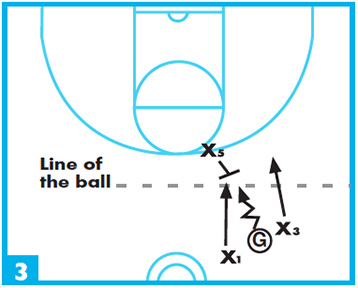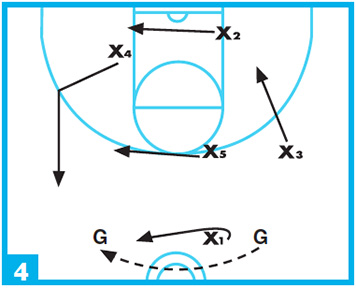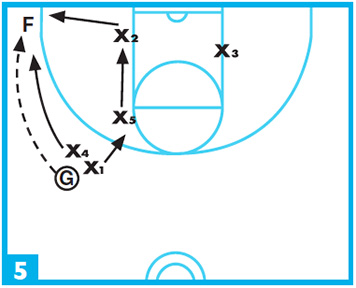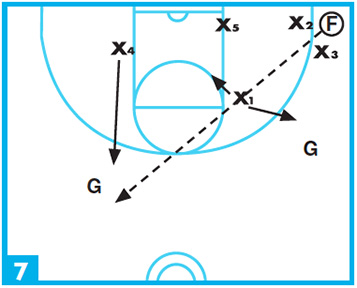An aggressive 1-3-1 zone for trap, half-court defenses
Initially, our 1-3-1 zone was intended to serve as a half-court trap in a multiple defense package. When the trap was broken, our players were instructed to fall back into another half-court defense, such as a 2-3 or 3-2 zone.
 We soon found, however, that our teams played the 1-3-1 zone better than any other defense. Plus, we discovered that only 2% of the teams in our area played a 1-3-1. This presented an advantage in that our opponents had to prepare differently to play our team, and opposing players feared the unknown. Ultimately, there was no reason to switch from the 1-3-1 when playing half-court defense.
We soon found, however, that our teams played the 1-3-1 zone better than any other defense. Plus, we discovered that only 2% of the teams in our area played a 1-3-1. This presented an advantage in that our opponents had to prepare differently to play our team, and opposing players feared the unknown. Ultimately, there was no reason to switch from the 1-3-1 when playing half-court defense.
DIAGRAM 1: Player positioning. Here are the initial positions and responsibilities for the half-court trap:
- X1: Typically the point guard, this player should pick up the ball handler at about 3/4. X1 should not crowd or play the handler too tight. Instead, they should “fake and retreat” at the ball before backing up into the passing lane so that the ball handler can’t pass to the weak-side guard. Ball reversal should be minimized, as it causes the other four defenders to adjust.
- X3, X4: These players should “invite” the ball handler to dribble over half-court. If they play too close to midcourt, the ball handler will try to reverse the ball or find a post player flashing to the ball. How far back the wings play depends on their quickness; the top of the key extended is a good landmark. These two players should be your quickest post players and possess good defensive instincts.
- X5: This player must deny any player flashing to the ball. While offensive players usually flash from below the foul line, X5 must be aware of a player flashing from the weak side.
- X2: This player starts on the ball-side box and takes the first ball-side pass. X2 comes out high to intercept the pass. As the “quarterback” of the defense, X2 is in the best position to see the floor and must actively communicate with their teammates. In particular, X2 should alert X5 when a player flashes to the ball.
 The purpose of this 1-3-1 zone defense is to create turnovers, so players shouldn’t play everything safely.
The purpose of this 1-3-1 zone defense is to create turnovers, so players shouldn’t play everything safely.
1-3-1 zone teaching points
Several teaching points are useful in successfully implementing the 1-3-1 half-court trap.
DIAGRAM 2: Squaring up on ball reversal. When there is a guard-to-guard ball reversal, X1 must immediately “square up” to the ball. This means getting their feet facing the off-side guard, with arms extended to the side, to thwart a subsequent reversal pass. Only after squaring up should X1 close toward the ball.
Similarly, any time the ball is passed over the ball-side wing’s head, they must first “square up” to minimize the passing lane. If the wing closes on the ball without first squaring up, the pass can be easily returned, forcing defensive players to constantly change and rotate.
When the wing and point player form a trap, they cannot allow it to be split. Once the offense splits the initial trap, your defense becomes extremely vulnerable. Players must form knee-to-knee traps.
 DIAGRAM 3: Movements on split trap. When a trap is split, X5 must stop the ball while X3/X1 retreat to the line of the ball.
DIAGRAM 3: Movements on split trap. When a trap is split, X5 must stop the ball while X3/X1 retreat to the line of the ball.
To prevent sideline penetration, the wing must slide and put their outside foot on the sideline. This forces the ball handler out of bounds.
» ALSO SEE: Teaching, implementing a match-up zone defense
If the ball handler pulls up the dribble in this trap, X3 and X1 must close in and make it difficult to make a solid, snap pass. They can accomplish this by extending their arms to block the view of the trapped guard. They must not allow the ball handler to “survey” the floor and throw cross-court or to the baseline. The trap succeeds when they can force a rainbow pass that can be picked off.
 DIAGRAM 4: Guard-to-guard ball reversal. On a guard-to-guard ball reversal, X4 must rotate up and out into the passing lane so that the opposing guard can’t make a quick pass to the corner. X4 must move laterally to prevent the guard from penetrating the middle of the floor or on the sideline until X1 gets over for the trap.
DIAGRAM 4: Guard-to-guard ball reversal. On a guard-to-guard ball reversal, X4 must rotate up and out into the passing lane so that the opposing guard can’t make a quick pass to the corner. X4 must move laterally to prevent the guard from penetrating the middle of the floor or on the sideline until X1 gets over for the trap.
As X4 rotates up, X5 follows the ball to the opposite elbow. X2 cuts along the baseline to the ball-side box, and X3 rotates down to protect the weak side.
DIAGRAM 5: Ball-side corner movements. On a pass from the guard to the ball-side corner, X2 goes out to play the ball “baseline strong” to prevent the offensive player from penetrating along the baseline. X5 must drop from the elbow to the ball-side box and deny any low-post players. X1 drops to the ball-side elbow and X3 protects the weak side from the weak-side box.

It’s critical that X4 to “square up” before following the ball to the corner. This technique makes a quick return pass to the guard difficult.
DIAGRAM 6: Corner-to-guard pass. If a pass is made from the corner back out to the guard, the zone is “pushed” back out into the passing lane. X1 pops back out into the passing lane from the elbow. X5 moves from the low box to the ball-side elbow, and X3 moves out from the weak-side box to a midpoint between the elbow and the baseline. X4 first turns, faces the ball and “squares up” before moving up toward the ball.
In man-to-man defenses, the side opposite the ball is often called the help side to encourage rotation and help. In a 1-3-1 zone defense, it’s appropriate to use the term “weak side” to reinforce aggressiveness and the objective of always going for the ball and a steal. Players are not in a help mode, and there will usually be four defenders on the ball side and only one on the weak side.
 Transition defense
Transition defense
Once in our half-court 1-3-1 — a verbal cue alerts players to stay in the defense — players can trap in the corners. The corner trap is cued by shouting “clamp!” and a visual cue consists of putting our hands together with fingers interlocked. The corner trap can be turned on and off as with any other defense, and changes could be made in mid-possession if necessary.
DIAGRAM 7: Corner trap. When there’s a trap in the corner, X1 is in position to anticipate a return pass from the corner to the guard. Therefore, X1 must extend their left arm and move an arm’s length away from any post player at the elbow to release on the pass.
 From the weak-side box position, the weak-side wing (X4) must learn to anticipate the diagonal pass from the corner trap to the guard on the other side. Also, because the offensive player in the corner is in trouble, X5 must front any low-post player. Otherwise, a pass to the post is the easiest pressure release for the offense.
From the weak-side box position, the weak-side wing (X4) must learn to anticipate the diagonal pass from the corner trap to the guard on the other side. Also, because the offensive player in the corner is in trouble, X5 must front any low-post player. Otherwise, a pass to the post is the easiest pressure release for the offense.
One of the weaknesses of a 1-3-1 zone is weak-side rebounding. For that reason, it’s critical to drill this aspect. Weak-side rebounding drills should teach players how to locate the potential weak-side rebounder, cut down the angle, and reduce the distance that the rebounder can run to the basket. As with all rebounding, the wing must pivot and make contact with the rebounder.
Other looks
While the point guard is usually in the X1 position, you can mix things up and place a taller player here. This is effective against teams that like to reverse the ball one or two times before initiating their offense. You also can put a taller player in the X2 position. This helps you to better contest a team’s 3-point shooter in the corners.
With minor adjustments and a little creativity, the 1-3-1 can become a defense for all occasions.
David Hoch, CMAA, has 16 years of experience as a high school athletic director and served for 12 years as the executive director of the Maryland State Coaches Association. He also was a collegiate and high school basketball coach in Pennsylvania.









